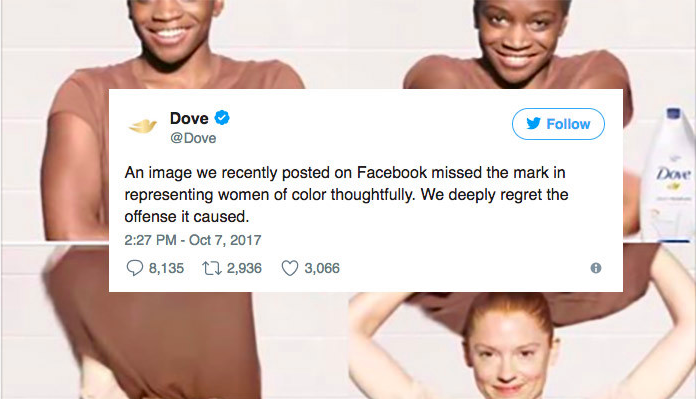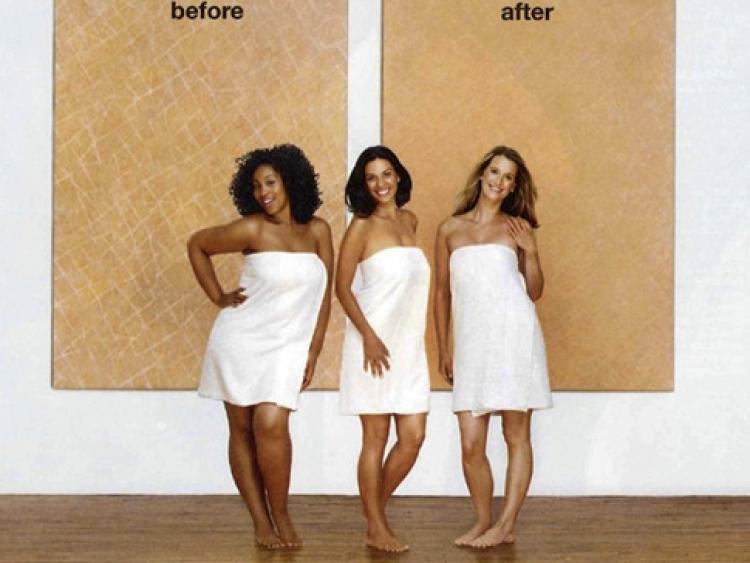
Who’s On Your Creative Team?
By Kate Faigen
“History repeats itself.” Bath and beauty product manufacturer Dove would have been wise to take this cautionary proverb to heart before their latest brand blunder. The social media world exploded in contempt this month over a three-second GIF that Dove posted to Facebook. The image, which showed a black woman peeling off a dark t-shirt to reveal a white woman taking off a white t-shirt, isn’t the first time Dove has misfired on issues of race. Like an earlier Dove ad, it harkened back to a trope in soap advertisements of the late 19th century: when products were implied to turn darker (or “dirty”) skin to a lighter tone, a supposed symbol of purity.
Of course, Dove pulled the ad and issued an apology in response to outrage; they stated that the company is “re-evaluating our internal processes for creating and reviewing content.” While Dove’s shift into damage control was nimble, it’s ironic that this area continues to be a stumbling block for a company that seeks to be known for embracing the unique, true beauty of all women.
When history repeats itself, especially given the legacy of race in soap advertising, the likelihood of an honest mistake diminishes. The question for Dove is: are these missteps merely a misguided attempt to attract attention? Or do they represent a fundamental misunderstanding of Dove’s messaging by their creative team?
Several writers have suggested fault for this campaign is rooted in the structure of Dove’s creative team, calling into question “their approval process, their execution, and general common sense.” Dove has been hit with accusations that its team is not aware of the history of the soap advertising industry, that they do not consider the opinions of the “real women” they intend to promote, and that they are not truly “committed to helping all women realize their personal beauty potential.” The technical abilities of the Dove team are clearly top-notch, but teams are more than a group of people with the skills to execute a task — they require the right mix of personalities to function well.
Dove’s mission is to represent the beauty of diversity, whether it be body shape, race, or age. The landmark Real Beauty campaign, which included “real” women in the place of models, earned Dove the trust of a slew of evangelists by presenting beauty as a source of confidence — instead of anxiety — for all women. Dove so perfectly expressed its brand promise that it became a safe haven for women who felt alienated by the beauty product industry.
Those existing expectations make even a three-second disappointment all the more painful. Everyone on Dove’s team needs to commit to the promise of empowering all women to cultivate self-esteem, particularly within a society that promotes unrealistic standards of beauty in advertising. Yet, those behind the messaging failed to recognize the offensive messaging — meaning people of color, rightfully, called into question a core element of the brand promise. Poor judgment once is a mistake, but repeated missteps beg the question: does Dove understand its brand as its customers do?
Self-image is an emotional, personal topic for consumers. Any company that speaks on that level, from giant Dove to the youngest startup, must handle the topic with tact and create a culture of acceptance. And then, they must live it each day and in every interaction with their audience. That means the story doesn’t start with an ad campaign: it begins with the right team, and an internal culture that emphasizes making all decisions derivatives of that narrative. That means team makeup, as opposed to skills, are the most “significant role in determining team performance.” In other words, aligning team members behind the mission is more paramount to success than their abilities — as Dove’s technically perfect but narratively confused campaigns demonstrate.
The most recent ad may be in the forefront of people’s minds today, but there is a second Dove ad that compounds the alarm about the company’s message. In 2011, Dove executed a campaign that featured three women against a backdrop of two types of skin, one that’s desired, and one that could be made desirable. Here, the models are lined up by skin tone, with the lighter-skinned woman placed furthest to the right, where smoother, cleaner skin is signified. Although the objective was to sell a product that evened out skin roughness, the echo of historic soap advertising and the racial implication were clear.

Dove always maintained the ad had the best intentions. Similarly, Lola Ogunyemi, the African American model in the recent GIF ad, weighed in with an op-ed piece arguing the brand’s vision was misinterpreted: “All of the women in the shoot understood the concept and overarching objective — to use our differences to highlight the fact that all skin deserves gentleness.”
Dove’s strong brand message, support of those involved in the ads themselves, and their response to the uproar indicate these haven’t been shameless attempts to grab attention. Still, the before-and-after nature of both ads raises an alarm: repeated campaigns showing a darker-skinned woman transforming into a lighter-skinned woman are clearly not congruent with the true beauty promise of Dove.
It’s impossible not to see these ads in context of the historical use of race in beauty product advertising. By equating cleanliness and beauty with whiteness, both campaigns imply a clear sense of superiority and civilization tied to skin tone. How could Dove think this would be embraced by their audience?
Dove’s campaign clearly was not malicious, but it was certainly ignorant. The only reasonable explanation for that is a dissonance within the organization; a separation between the story Dove tells the world, and the values it reinforces internally. In this case, that tension became public — with embarrassing results. With a compelling, noble company-wide vision to create products that appeal to all types of women, it is unfortunate the Dove team continues to misfire. Moving forward for Dove, and for any company that is having trouble clearly communicating their message to consumers, requires two steps.
The first is to clearly codify the brand story. Having a clear story in place provides the framework organizations need to make decisions, and motivates consumers to invest in a product. In addition to evangelism, a core story motivates employees, defines company culture, and provides a vision to attract investors and define future product development. In order to continue to see success in the future, Dove must live out its promise and align its messaging with its story of real beauty.
The second is to ensure that its team members are not only committed to its brand promise, but that they’re equipped with the right psychological factors. Any team must be able to empathize with its audience. By hiring the right people, or those with the emotional intelligence and cultural awareness necessary to authentically tell their story, Dove can avoid this public shame in the future.
Advertising is often the first way a potential consumer interacts with a brand’s story. Ensuring that message is communicated clearly, and accurately, is of the utmost importance. For brands looking to send the correct message outward, they should begin by looking inward: first by defining their story clearly, and then by holding every person on the team accountable for living it fully each and every day.
Kate Faigen is an associate at Woden. Whatever your storytelling needs may be, let Woden help. Read our free StorytellingBlueprint, or send us an email at connect@wodenworks.com to discuss how we can help tell your story.


